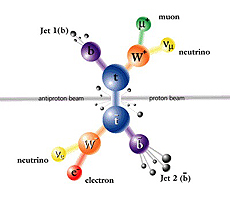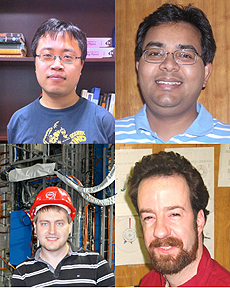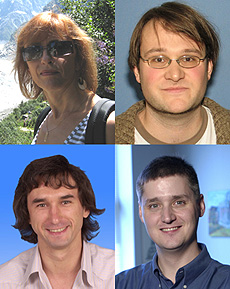Measure thrice, theorize once
 |
| This shows the production of a top-antitop pair decaying in the dilepton channel. In this case the top quark decays into an antimuon, and the antitop decays into an electron. |
Disponible en español
One of the very fundamental but unpredictable numbers in the Standard Model is the mass of the top quark. Like the strength of gravity, it is one of those numbers that has no explanation and yet is crucially linked to the kind of universe we live in. As Fermilab scientist Chris Quigg wrote in 1994, the year before the discovery of the top quark,
Through the uncertainty principle of quantum mechanics, top quarks and antiquarks wink in and out of an ephemeral presence in our world. Though they appear virtually, fleetingly, on borrowed time, top quarks have real effects. ... In fact, the mass of the top quark is encoded in the strengths of all the forces that rule the everyday world.
So, how do we determine this fundamental parameter? There are three basic ways, though there are many variations on these three themes.
Top quarks are mostly produced together with their corresponding antiquarks. Each decays into a W boson and a b quark, which creates a collimated spray of hadrons, called a jet. Each W can decay into either jets (usually two of them) or a lepton and neutrino. By leptons, we mean only electrons or muons. The neutrinos are undetectable. The final outcome then might be just jets (six of them), four jets with one lepton, or two jets with two leptons. So there are three different decay "channels" or "modes": the all-jets, leptons+jets and dilepton channels, respectively.
Measurements in each of the three modes present different advantages and different challenges. The dilepton channel has the advantage that it is particularly "clean," meaning that very few of the events that are selected for use in the measurement are not real top-antitop events. It has a challenge in that relatively few decay into dileptons — only about 4 percent of top-antitop pairs.
DZero has recently measured the mass of the top quark in the dilepton channel using the full Tevatron data set. There were two important variations on the theme that we chose. One was to select events so as to make the best of the small number of dilepton events available. The other was to use the jet energy calibration from the lepton+jet channel to understand the jets that are produced along with leptons in dilepton events. The result, 173.3 ± 1.6 GeV, is the most precise top quark mass measurement using the dilepton channel at the Tevatron. It is competitive with the best LHC dilepton measurements and is consistent with the average of all the top mass measurements made worldwide.
So that is one of the three ways of measuring the top mass. The other two methods also have been used at the Tevatron and the LHC. As for theorizing once, a goal of the single Theory of Everything is to provide some understanding of fundamental parameters that now have no explanation, even if they are well measured — such as the top mass. We hope one day we will arrive at such a summary of all of particle physics.
—Leo Bellantoni
 |
| Huanzhao Liu, Amitabha Das, Yuriy Ilchenko and Robert Kehoe, all of Southern Methodist University, contributed to the analysis for this measurement, which is the subject of Liu's Ph.D. thesis. |
 |
| The DZero collaboration relies upon many of its collaborators to carefully review analyses for scientific quality before they are released. This analysis was guided to completion by Editorial Board Chair Liza Shabalina (Physikalisches Institut, Georg-August-Universtät Göttingen, Göttingen, Germany) and the physics group conveners, Andy Jung (Fermilab), Slava Shary (CEA Irfu, Saclay, France) and Breese Quinn (University of Mississippi). |
|